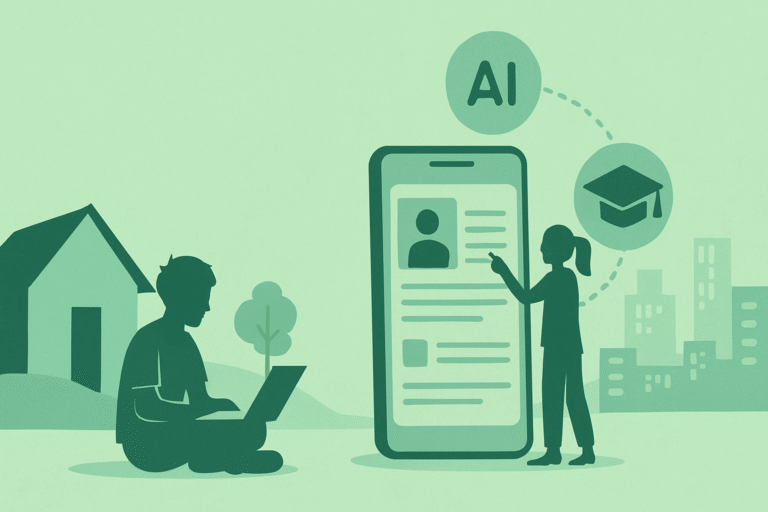Artificial intelligence has become a powerful force, reshaping industries and influencing our daily lives. While conversations around AI often revolve around efficiency, automation, and even replacement, a significant and quieter revolution is also underway: the use of AI to foster inclusivity. By designing technology that adapts to diverse human needs, AI is not just changing what we can do, but fundamentally expanding who can participate.
For a long time, “assistive technology” meant special add-on tools designed to help people fit into a world that wasn’t built for them. Now, AI is creating a major turning point for disability inclusion. Instead of creating fixes later, AI allows us to build accessibility directly into our digital and physical worlds from the very beginning, shifting it from an afterthought to a core part of the design process.
This article explores the development of Google’s Project Euphonia and its resulting product, the Relate app, as an example to showcase how AI can catalyse inclusivity. In 2018, Google launched Project Euphonia as a research initiative with the explicit goal of improving technology’s accessibility for individuals with impaired speech.
What Inspired Project Euphonia?
The rise of voice-activated technologies has created a new digital divide. Commercial Automatic Speech Recognition (ASR) systems have incredible voice recognition abilities for typical speakers but fail for those with speech disabilities. An estimated 250 million people worldwide with non-standard speech patterns – resulting from conditions such as amyotrophic lateral sclerosis (ALS), cerebral palsy, or stroke – find mainstream ASR systems largely unusable.
The main issue is that these AI systems are trained on massive amounts of “typical” speech and haven’t learned from the unique speech patterns of people with these conditions. This creates a vicious cycle: the AI fails due to a lack of relevant data, so disappointed users don’t re-engage with the technology, and their data never gets collected to fix the problem.
To solve this, Google’s goal was to create a personal AI for each user – a “one-size-fits-one” model. This technology learns an individual’s unique voice, creating a custom model that can understand them perfectly. This approach situates personalized ASR within the broader context of AI’s transformative role in Assistive Technology (AT) and Augmentative and Alternative Communication (AAC).
How Project Euphonia Works
The Groundwork
Recognizing the fundamental data scarcity problem, Google’s strategy was rooted in collaboration. The project placed a particular emphasis on serving individuals with progressive neurodegenerative conditions like ALS, for whom voice interaction often becomes the primary means of communication as physical mobility diminishes.
A pivotal early partnership was formed with organizations like the ALS Therapy Development Institute (ALS TDI), which provided access to a pre-existing repository of voice recordings from individuals with ALS. Throughout its data collection campaign, Google’s teams gathered over a million speech samples from thousands of individuals, creating one of the largest datasets of its kind to form the foundation of the app’s personalization capabilities.
The primary objective of Project Euphonia was to move beyond academic research and develop practical, personalized ASR systems. The goal was not just to improve transcription but to restore a measure of autonomy and connection. This initial seed data from partners was used to build a functional prototype, which was then productized into a free app, Relate.
The User Journey
First, the user teaches the app to understand their specific way of speaking by recording 500 pre-determined phrases. Google’s servers then process these recordings to build a custom voice recognition model. This process takes a few days, and the app notifies the user when it’s ready.
Once the personalized model is active, the user can use three main tools:
- Listen: Turns the user’s speech into text on the screen in real-time.
- Repeat: Listens to what the user says and repeats it aloud in a clear, computerized voice.
- Assistant & Keyboard: Connects the user’s voice model to their entire Android phone, allowing them to control their phone and smart home devices with their voice.
The Challenges
- Lab vs. Real Life: The technology works best in quiet settings and struggles with background noise or long, spontaneous conversations.
- User Effort: The initial training requires recording hundreds of phrases, which can be difficult for some users.
- Data Privacy: Voice recordings are personal and sensitive. Ethical questions remain about how this data is used, especially since users are providing free data to improve Google’s AI.
Key Takeaways from Project Euphonia: A Blueprint for Inclusive AI
The development of Project Euphonia and its evolution into the Relate app provides a clear and powerful blueprint for how to build AI that serves everyone. Its success lies in its strategic, human-centered approach.
1. Nothing About Us Without Us
Project Euphonia’s success is rooted in the principle of “Nothing About Us Without Us.” Through direct partnerships with organizations like the ALS Therapy Development Institute and thousands of individuals with speech impairments, Google solved real problems through community collaboration.
2. Focus on Quality Data, Not Just Quantity
The core problem for standard speech recognition was a lack of data from people with speech disabilities. Project Euphonia solved this by meticulously curating a high-quality, representative dataset of over a million speech samples.
3. Build for the Individual, Not the “Average” User
Project Euphonia’s entire model is built on personalization. It rejects the “one-size-fits-all” approach that excludes so many people and instead creates a custom speech model tailored to each person’s unique voice, empowering the AI to adapt to them, not the other way around.
4. Use AI to Empower, Not Replace
Project Euphonia doesn’t aim to replace a person’s voice but to amplify and clarify it. Features like “Listen” and “Repeat” are tools that augment the user’s natural abilities, bridging the communication gap between them and the world.
Watch about Project Euphonia here!
Project Euphonia: Helping everyone be better understood
Sources:
- https://www.youtube.com/watch?v=OAdegPmkK-o
- https://www.youtube.com/watch?v=McA3a2ZNbO4
- https://www.youtube.com/watch?v=C6fc6f48RX8
- https://www.youtube.com/watch?v=6V6fMBbogJs
- https://nagish.com/thebuzz/from-haptic-devices-to-ai-how-one-mathematician-changed-speech-recognition
- https://research.google/blog/project-euphonias-personalized-speech-recognition-for-non-standard-speech/
- https://blog.google/outreach-initiatives/accessibility/impaired-speech-recognition/
- https://www.als.net/news/project-relate/
- https://www.als.net/news/project-euphonia-age-of-ai/
- https://www.isca-archive.org/interspeech_2021/macdonald21_interspeech.pdf
- https://research.google/blog/responsible-ai-at-google-research-ai-for-social-good/




